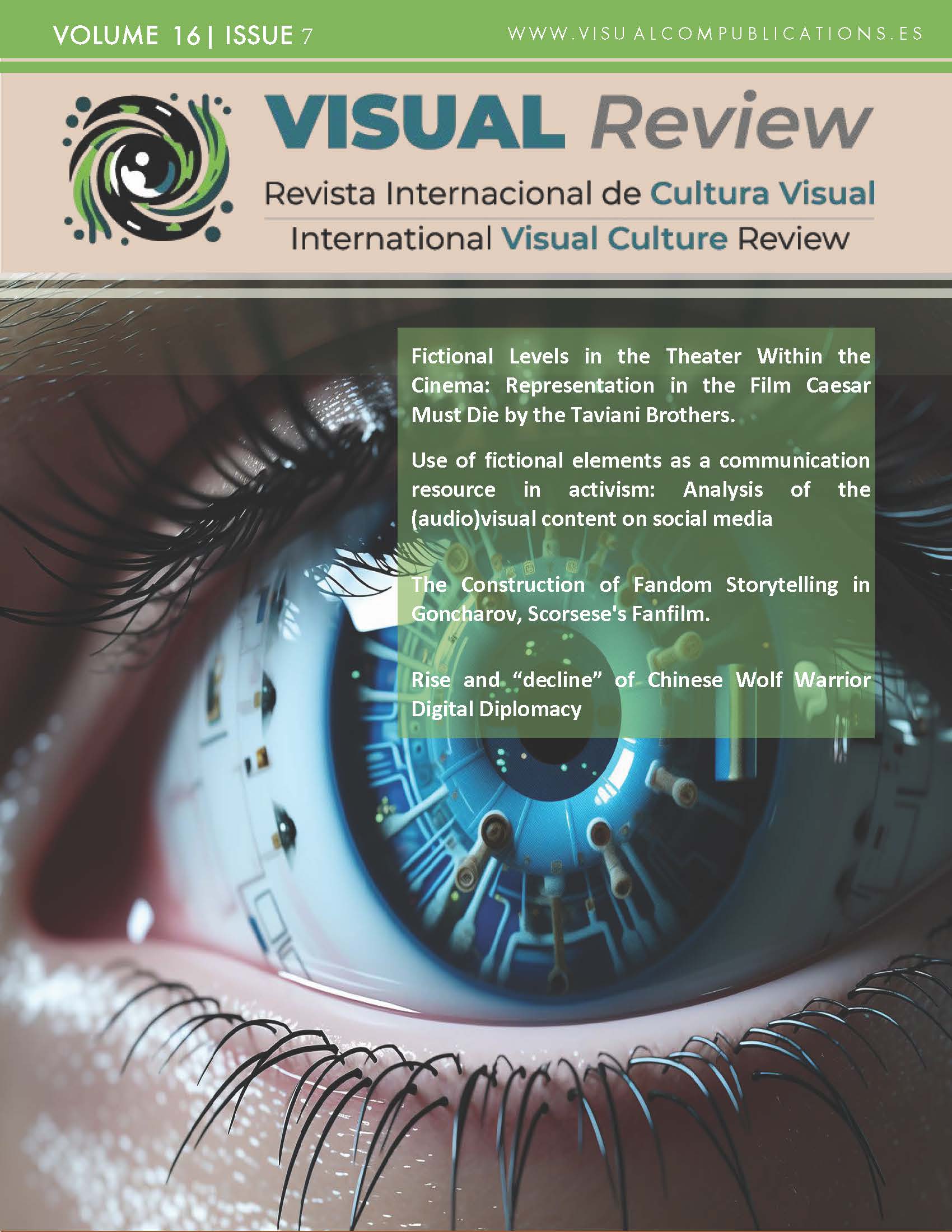Elements of Fiction as a Communicative Resource in Activism
Analysis of the (audio)visual content on social media
DOI:
https://doi.org/10.62161/revvisual.v16.5355Keywords:
Activism, Fiction, Social media, Mainstream culture, Visual communication, Climate activismAbstract
The article proposes a study of the elements of fiction as a communicative resource in the context of contemporary activism. To this end, the analysis encompasses the examination of visual and audiovisual content published by Greenpeace and Extinction Rebellion on X and Instagram over a six-month period. The research has identified a series of categories that articulate these fictional elements, namely the meme, the comic, the performance, the short video, and the animated video. Finally, the article presents conclusions regarding the use of fiction, which is frequently associated with references to mainstream culture.
Downloads
Global Statistics ℹ️
|
529
Views
|
364
Downloads
|
|
893
Total
|
|
References
Auslander, P. (2023). Liveness. Performance in a Mediatized Culture. Routledge DOI: https://doi.org/10.4324/9781003031314
Boykoff, M. y Osnes, B. (2018). A Laughing Matter? Confronting climate change through humor. Political Geography, 68, 154-163. DOI: https://doi.org/10.1016/j.polgeo.2018.09.006
Cordero-Sánchez, I. y Alberich-Pascual, J. (2015). Revisión de usos sociales y formas de ejercer la política a través de los nuevos medios. El Profesional de la Información, 24(6), 811-818. DOI: https://doi.org/10.3145/epi.2015.nov.13
Davison, P. (2012). The Language of Internet Memes. En M. Mandiberg (Ed.), The Social Media Reader (pp. 120-134). New York University Press. DOI: https://doi.org/10.18574/nyu/9780814764077.003.0013
Delaure, M. y Fink, M. (2017). Introduction. En M. Delaure y M. Fink (Eds.), Culture Jamming. Activism and the Art of Cultural Resistance (pp. 1-39). New York University Press. DOI: https://doi.org/10.18574/nyu/9781479850815.003.0005
Duncombe, S. (2020). Training Activists to be Fans: “The Moral Equivalent” of Pop Culture. En H. Jenkins, G. Peters-Lazaro y S. Shresthova (Eds.), Popular Culture and The Civic Imagination. Case Studies of Creative Social Change (pp. 186-195). New York University Press. DOI: https://doi.org/10.18574/nyu/9781479891252.003.0020
Igartua, J. J. (2006). Métodos cuantitativos de investigación en comunicación. Bosch.
Jenkins, H., Shresthova, S., Gamber-Thompson, L., Kligler-Vilenchik, N. y Zimmerman, A. M. (2016). By Any Media Necessary. The New Youth Activism. New York University Press.
Jenkins, H. y Shresthova, S. (2016). “It’s Called Giving a Shit!” What Counts as “Politics”? En H. Jenkins, S. Shresthova, L. Gamber-Thompson, N. Kligler-Vilenchik y A. M. Zimmerman, By Any Media Necessary. The New Youth Activism (pp. 253-290). New York University Press. DOI: https://doi.org/10.18574/nyu/9781479829712.003.0010
Jenkins, H. (2016). Youth Voice, Media, and Political Engagement. Introducing the Core Concepts. En H. Jenkins, S. Shresthova, L. Gamber-Thompson, N. Kligler-Vilenchik y A. M. Zimmerman, By Any Media Necessary. The New Youth Activism (pp. 1-61). New York University Press. DOI: https://doi.org/10.18574/nyu/9781479829712.003.0004
Huntington, H. E. (2013). Subversive Memes: Internet Memes as a Form of Visual Rhetoric. AoIR Selected Papers of Internet Research, 14.
Locher, M. A. y Jucker, A. H. (2021). The Pragmatics of Fiction. Literature, Stage and Screen Discourse. Edinburgh University Press. DOI: https://doi.org/10.1515/9781474447959
Lund, M. (2018). Comics Activism, a (Partial) Introduction. Scandinavian Journal of Comic Art (SJoCA), 3(2), 39-54.
Milner, R. M. (2013). Pop Polyvocality: Internet Memes, Public Participation, and the Occupy Wall Street Movement. International Journal of Communication, 7.
Neuendorf, K. A. (2002). The Content Analysis Guidebook. Sage..
Nordenstam, A. y Wallin Wictorin, M. (2023). Climate Activism – Contemporary Swedish Feminist Comics. Journal of Graphic Novels and Comics, 14(5), 735-747. DOI: https://doi.org/10.1080/21504857.2022.2075413
Pérez Salazar, G. (2017). El meme en internet. Identidad y usos sociales. Fontamara/Universidad Autónoma de Coahuila.
Ruiz Martínez, J. M. (2018). Una aproximación retórica a los memes de internet. Revista Signa, 27, 995-1021. DOI: https://doi.org/10.5944/signa.vol27.2018.21856
Serafini, P. (2018). Performance Action. The Politics of Art Activism. Routledge. DOI: https://doi.org/10.4324/9781315183596
Tatarchevskiy, T. (2011). The ‘popular’ culture of internet activism. New Media & Society, 13(2), 297-313. DOI: https://doi.org/10.1177/1461444810372785
Torre-Espinosa, M. de la (2019). Política y autoficción performativa en Zonas de dolor, de Diamela Eltit. Catedral Tomada. Revista de Crítica Literaria Latinoamericana, 7(12), 71-95. DOI: https://doi.org/10.5195/ct/2019.385
Wimmer, R. D. y Dominik, J. R. (1996). La investigación científica de los medios de comunicación. Una Introducción a sus métodos. Bosch.
Downloads
Published
How to Cite
Issue
Section
License
Copyright (c) 2024 VISUAL REVIEW. International Visual Culture Review / Revista Internacional de Cultura Visual

This work is licensed under a Creative Commons Attribution-NoDerivatives 4.0 International License.
Those authors who publish in this journal accept the following terms:
-
Authors retain copyright.
-
Authors transfer to the journal the right of first publication. The journal also owns the publishing rights.
-
All published contents are governed by an Attribution-NoDerivatives 4.0 International License.
Access the informative version and legal text of the license. By virtue of this, third parties are allowed to use what is published as long as they mention the authorship of the work and the first publication in this journal. If you transform the material, you may not distribute the modified work. -
Authors may make other independent and additional contractual arrangements for non-exclusive distribution of the version of the article published in this journal (e.g., inclusion in an institutional repository or publication in a book) as long as they clearly indicate that the work was first published in this journal.
- Authors are allowed and recommended to publish their work on the Internet (for example on institutional and personal websites), following the publication of, and referencing the journal, as this could lead to constructive exchanges and a more extensive and quick circulation of published works (see The Effect of Open Access).













